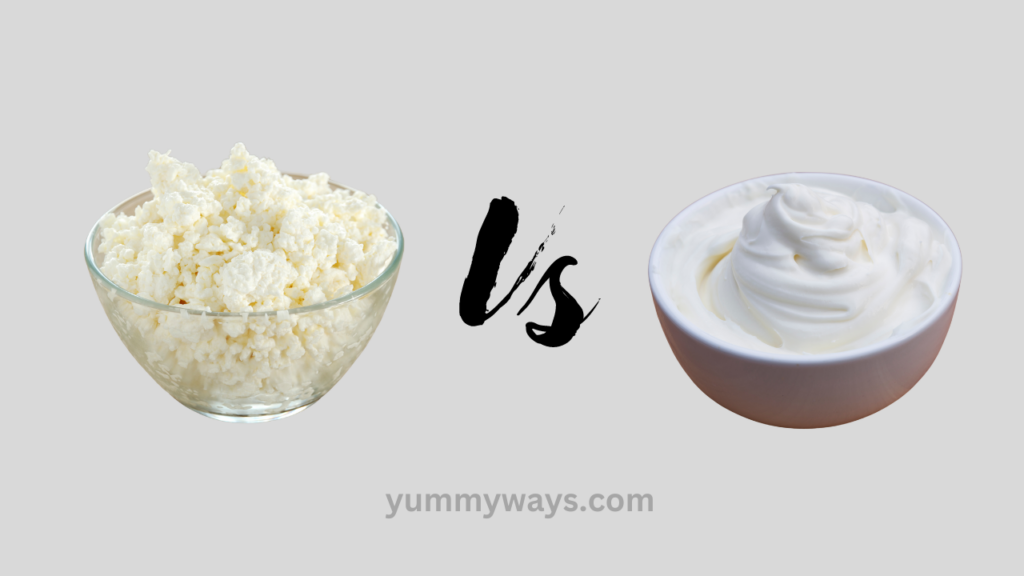Cottage cheese and sour cream are both creamy dairy products that differ in texture and taste. In the world of dairy products, cottage cheese, and sour cream stand out as two popular choices.
Both are creamy, white, and perfect for enhancing the flavors of various dishes. However, they differ in terms of texture and taste. Cottage cheese has a chunky, curd-like texture and a mild, slightly tangy flavor. On the other hand, sour cream has a smooth, thick consistency and a tangy, creamy taste.
Whether it’s adding richness to a baked potato or incorporating creaminess into a dip, understanding the distinctions between cottage cheese and sour cream can help you make the perfect choice for your culinary creations.
Contents
Cottage Cheese Vs Sour Cream

Also Read: Why Does Swiss Cheese Taste Bad? Uncover the Mystery!
Nutritional Value
Cottage cheese and sour cream are two popular dairy products that are commonly used in cooking and baking. Understanding the nutritional value of these two ingredients can help you make informed decisions about which one to incorporate into your diet. Let’s explore the nutritional value of cottage cheese vs. sour cream in terms of their protein content and caloric comparison.
Protein Content
Cottage cheese is known for its high protein content, making it a favorite among fitness enthusiasts and those looking to increase their protein intake. A 1-cup serving of cottage cheese typically contains around 28 grams of protein. This makes it an ideal option for individuals following high-protein diets or looking to boost their muscle recovery and growth.
On the other hand, sour cream contains significantly less protein compared to cottage cheese. A 1-cup serving of sour cream contains only around 5 grams of protein, making it a less suitable option for individuals seeking a high-protein dairy product.
Caloric Comparison
When it comes to caloric comparison, cottage cheese tends to be lower in calories compared to sour cream. A 1-cup serving of low-fat cottage cheese typically contains approximately 200 calories. This makes it a suitable choice for those aiming to manage their caloric intake while still obtaining a good source of protein and other essential nutrients.
Conversely, sour cream is higher in calories compared to cottage cheese. A 1-cup serving of sour cream can contain around 450 calories, which is notably higher than the caloric content of cottage cheese. For individuals looking to watch their calorie consumption, opting for cottage cheese over sour cream may be a more favorable choice.
Health Benefits
Cottage cheese and sour cream are both creamy and versatile dairy products, but when it comes to health benefits, cottage cheese takes the lead. With lower fat and calorie content, higher protein and calcium, and gut-friendly probiotics, cottage cheese is a nutritious choice for your diet.
Calcium And Bone Health
Cottage cheese and sour cream are both rich in calcium, an essential mineral for maintaining strong and healthy bones. Calcium is especially important during childhood and adolescence when bones are growing rapidly, and in later years to prevent bone loss and the development of conditions like osteoporosis.
Adequate calcium intake is crucial for individuals of all ages. A single serving of cottage cheese provides approximately 10% of the daily recommended intake of calcium for adults, while sour cream provides about 7% of the daily recommended intake. Including these calcium-rich dairy products in your diet can be a convenient and delicious way to maintain good bone health.
Also Read: How Pepper Jack Cheese is Made? A Spicy Revelation!
Probiotics And Gut Health
Both cottage cheese and sour cream contain beneficial probiotics that promote gut health. Probiotics are live microorganisms that help maintain the balance of good bacteria in the digestive system, improving digestion and supporting overall gut health.
While cottage cheese provides live cultures of Lactobacillus, a commonly used probiotic strain, sour cream contains a smaller amount of these beneficial bacteria due to its fermentation process. Nevertheless, including either cottage cheese or sour cream in your diet can help support a healthy gut microbiome.
A balanced and diverse gut microbiome is associated with numerous health benefits, including improved digestion, enhanced immune function, and even mental well-being. By incorporating cottage cheese or sour cream into your meals, you can contribute to a healthy gut environment and support optimal overall health.
Taste And Texture
Cottage cheese is known for its lumpy texture and tangy taste, making it a versatile ingredient in many dishes. Meanwhile, sour cream offers a creamy and smooth texture with a slightly sour flavor that complements various foods. Both have their unique characteristics, giving you options for different recipes.
Creaminess
When it comes to taste and texture, the creaminess of both cottage cheese and sour cream plays a pivotal role. Cottage cheese, with its lumpy curds, has a uniquely rich and creamy texture that is loved by many. Its curds are tender yet slightly grainy, providing an interesting mouthfeel that is both creamy and satisfying. This creaminess adds a delightful touch to various dishes, making cottage cheese a versatile ingredient.
Sour cream, on the other hand, boasts a smooth and silky creaminess that is both decadent and luxurious. Its texture is velvety, offering a melt-in-your-mouth sensation. This creaminess is particularly well-suited for adding a rich element to both savory and sweet recipes. The smoothness of sour cream allows it to blend seamlessly into dips, dressings, and desserts, enhancing their overall texture and flavor.
Tanginess
Cottage cheese and sour cream diverge in terms of tanginess, adding distinct flavors to culinary creations. Cottage cheese exhibits a milder tang, lending a subtle hint of acidity to dishes. This tanginess enhances the creaminess of cottage cheese, balancing out its richness without overpowering the other flavors present in a dish.
In contrast, sour cream brings a stronger tanginess to the table. Its sharp and tangy flavor profile adds a zesty kick to dishes, infusing them with a vibrant burst of acidity. This tanginess makes sour cream an excellent companion for savory dishes such as tacos, baked potatoes, and soups, where its robust flavor can elevate the overall taste of a recipe.
Culinary Uses
Cottage cheese and sour cream are both versatile dairy products commonly found in many kitchens. Their creamy textures and slightly tangy flavors make them popular ingredients in various culinary applications. Let’s explore the culinary uses of cottage cheese vs. sour cream.
Cooking Applications
Cottage cheese and sour cream serve different purposes when it comes to cooking. Cottage cheese is a fantastic ingredient for enhancing the protein content of dishes while providing a creamy texture. Use it in recipes for pancakes, lasagna, or as a topping for baked potatoes. Sour cream, on the other hand, is often used as a rich, tangy addition to both hot and cold dishes. It’s a staple for creamy sauces and dressings, and as a topping for soups and stews.
Serving Suggestions
When it comes to serving suggestions, both cottage cheese and sour cream offer delightful options for a variety of dishes. Cottage cheese can be enjoyed on its own or with sweet additions like fruit and honey, or savory accompaniments such as herbs and spices. It is also commonly used as a light, protein-packed topping for dishes like salads and fruit bowls. Sour cream, with its tangy flavor, is often used as a condiment or garnish for dishes such as tacos, nachos, and baked potatoes, adding a creamy and slightly acidic dimension to the flavors.
Dietary Restrictions
When considering dietary restrictions, it’s important to weigh the options of cottage cheese and sour cream for those with specific needs. Below, we delve into the implications for individuals managing lactose intolerance and the availability of low-fat and fat-free choices.
Lactose Intolerance Considerations
- Cottage cheese generally contains less lactose than sour cream, making it a more suitable option for those with lactose intolerance.
- Individuals with lactose intolerance may find that cottage cheese is easier to digest due to its lower lactose content.
Low-fat And Fat-free Options
| Aspect | Cottage Cheese | Sour Cream |
|---|---|---|
| Low-fat options | Available in various low-fat varieties | Low-fat options may be limited |
| Fat-free options | Readily available in fat-free versions | Fewer fat-free alternatives compared to cottage cheese |
Cottage cheese is often a preferred choice for lactose intolerance due to its lower lactose content. Individuals with this condition may find it easier to digest compared to sour cream.
Low-fat and fat-free options are more prevalent in cottage cheese than sour cream. It provides more flexibility for those looking to reduce their fat intake.
Make informed choices based on your specific dietary needs to optimize your health and well-being.
Storage And Shelf Life
Cottage cheese typically has a longer shelf life compared to sour cream. Both can be stored in the refrigerator, but cottage cheese can last up to one week after opening, while sour cream usually lasts for about 1-2 weeks. It is important to check the expiration date and store them properly to maintain freshness.
Proper storage methods are crucial to maintain the freshness of cottage cheese and sour cream. When storing cottage cheese, always keep it sealed tightly in its original packaging or an airtight container in the fridge. For sour cream, ensure it is tightly sealed in its original container and stored in the coldest part of the fridge.
Proper Storage Methods
- Seal tightly in the original packaging
- Use an airtight container for cottage cheese
- Store sour cream in the coldest part of the fridge
Shelf Life Comparison
Cottage cheese typically has a shorter shelf life compared to sour cream. Cottage cheese should be consumed within about one week of opening, while sour cream can last up to two weeks after opening if stored properly in the fridge.
Sour cream has a slight edge in terms of shelf life, lasting up to two weeks if refrigerated correctly. On the other hand, cottage cheese should be consumed within a week of opening to maintain its freshness and quality.
Remember, following proper storage methods and being mindful of the shelf life of these dairy products can help you enjoy them at their best!
Final Verdict
The Final Verdict: After carefully comparing cottage cheese and sour cream in terms of nutrition, taste, and versatility, both have their unique strengths and applications. Let’s dive into which is better for different uses and wrap up with a summary and recommendations.
Which Is Better For Different Uses
- Cottage Cheese: Ideal for adding protein and texture to salads, and smoothies, and as a ricotta substitute in recipes.
- Sour Cream: Great for adding creaminess and tanginess to dishes like tacos, and baked potatoes, and as a topping for soups.
Summary And Recommendations
Both cottage cheese and sour cream serve distinct culinary purposes. When it comes to health, cottage cheese offers a protein-packed and low-fat option, while sour cream provides a rich and indulgent flavor. For a versatile and nutritious ingredient, consider incorporating cottage cheese into various meals. On the other hand, sour cream can be your go-to for enhancing the taste and texture of savory dishes. Ultimately, the choice between these two dairy products depends on your specific dish and dietary preferences.
Conclusion
Both cottage cheese and sour cream have their unique flavors and uses in cooking. Depending on the dish, one may be more suitable than the other. Ultimately, the choice between cottage cheese and sour cream depends on personal taste and dietary preferences.

